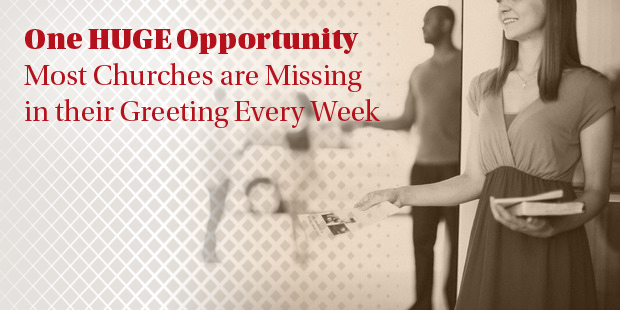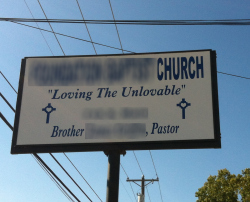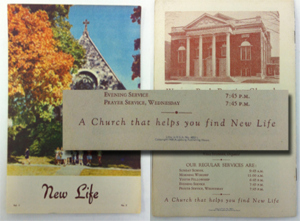
Welcoming Your Guests with Effective Website Practices
As a frequent traveler, nothing beats the feeling of being expected versus being accommodated. Creating break-thru clarity for church teams, as a navigator for Auxano, I have dozens of moments of engagement with hotel, rental car, airline and Starbucks employees every week. I love it when it feels like someone thought of me as their guest by expectation, rather than just thinking of the revenue I represent in accommodation
Earlier this year I arrived in a new city on a cold, rainy January night. My rental car company chose to give me a car on the far side of the lot, and not under the closer, warmer and dryer canopy. I had just been randomly assigned a car in row 700, and no one had thought about my experience in getting to it. Or so I was told.
Soon after, I observed a Sunday morning parking lot, as an obvious first-timer circled the guest parking area in the rain (past the member and staff cars who had parked there to be close) finally dropping his young family off at a door, just before the service start time. I wondered if the rain-soaked Dad felt expected or simply accommodated as he ran through the puddles to catch up with his family.
In the springtime, Sundays through Easter may be the most likely season of guest engagement your church will enjoy. Many pastors and church leaders use this time to assess their presence in the community by evaluating their visual vision elements (like signage and bulletins) and even considering a major web overhaul for the year.
Today, just about every guest visits your church online before they visit onsite.
A guest will view your digital front door before they walk through your physical front door. Your church website is the first, and most important place to create the feeling that a guest is expected at your church, rather than just able to be accommodated.
>> Here are 10 Guest Welcome Practices of Effective Church Websites:
A Logical Web Address – try to get as close to your actual church name using .com or .org, or both if possible. Do your best to avoid tagline-driven web addresses like “thecaringplace.com” or “growdeepwithus.org.” Don’t forget to use your new domain for connected guest information email addresses like info@yourchurch or pastor@yourchurch.
A Prominent “I’m New” Section – this is all about putting the cookies on the bottom shelf. Nine out of ten first-time guests will visit your website before your worship. This means that up to 80% of your website users are looking for service times and locations, and very little else. Your biggest button, banner or visual element should be geared toward newbies.
Obvious Church Information – keep your church address, phone number and service times highly visible, even if you have an I’m New section. In mobile format, move this information to the top as “clickable” information.
A Usable Maps Link – most maps providers allow for you to embed a link that facilitates creation of point to point directions for your first time guest. It is always a good idea to make sure your church location is accurate in Google.
Landmark Driving Directions – in addition to a maps link, harder-to-find churches should supplement with verbal turn-by-turn directions noting landmarks like exit numbers, community structures or natural features. Including a photo of the front of the church, or church sign, as viewed from the road also builds confidence that a guest could find you easily.
Actual Worship Imagery – set worship style and dress expectations by using engaging, HIGH QUALITY photography from an actual worship service. Pay a professional if you have to. Remember, no pictures on your website are better than bad or amateur pictures on your website.
Practical Children’s Information – your website is a natural place to build confidence in parents that your church or campus is a caring, secure and instructive environment for their children. Note security procedures and give an estimate of how much drop-off time to plan into their first visit. Note any special parking or family entrance locations.
Complete Worship Descriptions – avoid insider-only and cute names for worship services of different styles, this only widens the first-visit gap for an outsider. Be sure to describe what you mean by contemporary, modern or traditional. One great way to mine for the right language is to ask a guest or recent attender to describe your worship in their own words.
An Engaging Pastoral Welcome – demonstrating expectation is as simple as a written welcome note, thanking guests for visiting your online front door. You might even consider a professionally-produced video with imagery of worship, children’s environments and personal testimony. Anchor all of this content with Vision-Frame language and point to key next steps.
Active Social-Media Venues – leverage the interactions around your worship content and member engagement to draw potential guests to community. Feature pastors “in real life” and foster a sense of belonging. Consider relocating announcements and calendars from your church homepage to a Facebook organization page that is more likely to get updated and shared by your body. Instagram and Twitter may also serve to bring immediate attention, interaction and feedback to services or events.

Want to learn how to create an EXCEPTIONAL Guest Experience at your church? Check out Auxano’s Guest Experience Boot Camp, coming to Orlando, FL on April 3-4.

Tags: Attention, Awareness, Bryan Rose, church websites, websites






























